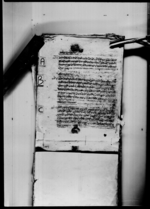A copy of a lālamohara from King Gīrvāṇayuddha appointing Vaijanātha Josī to conduct the Dasaĩ rituals at Gorkhā's Upallokoṭa (VS 1862)
ID: K_0029_0044A
Edited and
translated by Astrid Zotter
Created: 2017-05-31;
Last modified: 2023-02-17
For the metadata of the document, click here
The accompanying edition, translation/synopsis and/or commentary are available under the terms of the Creative Commons Attribution-ShareAlike 4.0 International License
Abstract
This copy of a lālamohara from the king, who according to the date must have been Gīrvāṇayuddha, appoints Vaijanātha Josī as being in charge of performing the Dasaĩ rituals at Gorkhā's Upallokoṭa, including recitation, worship (pūjā), fire sacrifice (homa), and animal sacrifice (balidāna).Diplomatic edition
[1r]
1९४नंरु[Seal of the Jaisīkoṭhā][Unknown seal]12आगेवैजनाथजोसीकेगोर्षाउपल्लोकोटकोदसैगर्नुमानगुठषेतस्मेतती
3मीलाईवक्स्यौपाठपुजाहोमवलीदानवेसगरीगरहामीलाईआसीर्वाद
4दीन्यागरगुठकोभोग्यगरईतिसम्वत१८६२सालमितिआसीनवदी
5१रोजशुभम्
Translation
[1r]
Āge: To Vaijanātha Josī
We [herewith] grant you, together with a field [endowed] as guṭha [land], the honour (māna) of performing the Dasaĩ [rituals at] Gorkhā's Upallokoṭa.3 Perform the recitation [of the Caṇḍī], the worship (pūjā), the fire sacrifice (homa), [and] the offerings of animal sacrifice (balidāna) in a fitting manner. Bestow regular blessings on us. Enjoy the guṭha).
…day,4 the 1st of the dark fortnight of Āśvina of the [Vikrama] era year 1862 (1805 CE). Auspiciousness.
Commentary
This text, found in an assemblage of lālamoharas (see n. 1), in all likelihood is a copy of an executive order (rukkā) of King Gīrvāṇayuddha. Not only this text is preceded by the abbreviation ru. The next text copied in the compendium (K_0029_0044B), ordering the courtiers (bhārādāra) in charge of the Dasaĩ rituals at Gorkha to provide certain items to Vaijanātha Josī for carrying out his ritual duties, has the same abbreviation preceding it. It is similar in phrasing to an original rukkā (DNA_0010_0019) regulating the annual provision of certain items to another ritual specialist involved in the Dasaĩ rituals of Gorkha Palace.
Moreover, the two documents K_0029_0044A and K_0029_0044B, issued on the same day and copied one after another, bear witness to the fact that when ritual specialists were appointed by royal decree, often several lālamoharas were issued, not just to the priest appointed (as in K_0029_0044A), but also to those whose duties were affected by this appointment (as in K_0029_0044B). The arrangement fixed by these two documents seems to have been a stable one. L. Bhaṭṭarāī in his 1997 monograph on the Gorkha palace complex describes the goddess of this fort (koṭa) being worshipped on the year’s two Dasaĩs in a way similar to what is stipulated in the present document ( Bhaṭṭarāī VS 2054: 121): On the Baḍā Dasaĩ, worship is carried out throughout the Navarātra period with one recitation of the Caṇḍī on each lunar day from the first to the ninth. On Caite Dasaĩ, worship takes place on aṣṭamī with only one recitation of the Caṇḍī. The Brahmin in charge on these two occasions receives a priestly fee of 250 rupees and 25 rupees from the Kausī Tosākhānā. On the Great Dasaĩ, homa and pūjā are performed, and one he-goat and one bull buffalo are sacrificed (ibid.: 72). On Caitrāṣṭamī, homa is performed, and one ram and one goat are sacrificed (ibid.: 90).
This office of priest seems to have been one reassigned fairly regularly to new persons, or else rotated among a fixed group, Vaijanātha Josī—in other documents also called Vaijanātha Arjyāla or Vaijanātha Josī Arjyāla—being the person most frequently mentioned. In VS 1864 (1807 CE) Narmaḍeśvara Jaisī Arjyāla was appointed to take over Vaijanātha's duties (K_0029_0025A). In August 1816 (VS 1873 Bhādra) duties shifted from Rāmacandra Arjyāla (back?) to two persons, Vaijanātha and Vetu Arjyāla (K_0013_0020E) to be again replaced by Rāmacandra Arjyāla in January 1817 (VS 1873 Māgha, K_0013_0022B). In 1822 (VS 1878) Vaijanātha is again mentioned as being replaced by Nityānanda Josī Arjyāla (K_0013_0033E). All appointees named in these documents came from the Arjyāla clan. Vaijanātha, Narmaḍeśvara and Nityānanda in particular are specified as being Josī (or Jaisī) Arjyālas. It is not known, however, whether this meant that they actually served as astrologers or only indicated their status as Jaisī Brahmins, which was lower than that of Upādhyāya Brahmins in the officially endorsed caste hierarchy. Arjyālas, both Upādhyā and Jaisī, were traditionally among the main Brahmins who served the Śāhas of Gorkha and their deities.

